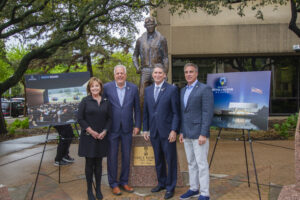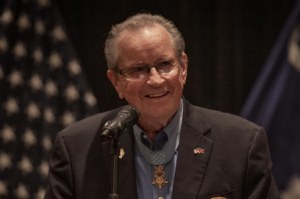 Every year in November, our Nation comes together to honor and remember the great men and women who have sacrificed and served in the U.S. armed forces. On this day, Veterans of every branch in the military are celebrated and honored for their commitment to their mission of U.S. security – Air Force and Air Force Reserve, Air National Guard, Army and Army Reserve, Army National Guard, Coast Guard and Coast Guard Reserve, Marine Corps and Marine Corps Reserve, Navy and Navy Reserve. From highly decorated war heroes, to reserve members who committed time stateside, from Veterans in their nineties spending quality time with their grandkids, to Veterans in their twenties figuring out their next step in life – we want to thank all Veterans for the commitment and sacrifices they have made to protect our freedoms.
Every year in November, our Nation comes together to honor and remember the great men and women who have sacrificed and served in the U.S. armed forces. On this day, Veterans of every branch in the military are celebrated and honored for their commitment to their mission of U.S. security – Air Force and Air Force Reserve, Air National Guard, Army and Army Reserve, Army National Guard, Coast Guard and Coast Guard Reserve, Marine Corps and Marine Corps Reserve, Navy and Navy Reserve. From highly decorated war heroes, to reserve members who committed time stateside, from Veterans in their nineties spending quality time with their grandkids, to Veterans in their twenties figuring out their next step in life – we want to thank all Veterans for the commitment and sacrifices they have made to protect our freedoms.

The Anniversary of the “eleventh hour of the eleventh day of the eleventh month”
This year, Veterans Day is extra special as it falls on the 100th anniversary of the original Armistice Day which is November 11, 1918. Armistice Day is commemorated each year as Veterans Day in America, however it is recognized by other countries as well to mark the armistice signed between the Allies of World War I, Germany, and Compiegne, France – which brought an end to World War I.
Medal of Honor Recipients from World War I
Over 120 men received the Medal of Honor for their actions during World War I, many of them leading up to Armistice Day. Below we highlight just a few of the many heroes that contributed to and sacrificed during WWI and helped bring the War to an end.
Captain Edward C. Allworth, U.S. Army, November 5, 1918
While his company was crossing the Meuse River and canal at a bridgehead opposite Clery-le-Petit, the bridge over the canal was destroyed by shell fire and Capt. Allworth’s command became separated, part of it being on the east bank of the canal and the remainder on the west bank. Seeing his advance units making slow headway up the steep slope ahead, this officer mounted the canal bank and called for his men to follow. Plunging in he swam across the canal under fire from the enemy, followed by his men. Inspiring his men by his example of gallantry, he led them up the slope, joining his hard-pressed platoons in front. By his personal leadership he forced the enemy back for more than a kilometer, overcoming machinegun nests and capturing 100 prisoners, whose number exceeded that of the men in his command. The exceptional courage and leadership displayed by Capt. Allworth made possible the re-establishment of a bridgehead over the canal and the successful advance of other troops.
After WWI, Captain Allworth went home to Oregon and joined his alma mater, Oregon Agricultural College, as secretary of the Alumni Association.
Private John L. Barkley, U.S. Army, October 7, 1918 
Pfc. Barkley was stationed in an observation post half a kilometer from the German line, on his own initiative, he repaired a captured enemy machinegun and mounted it in a disabled French tank near his post. Shortly afterward, when the enemy launched a counterattack against American forces, Pfc. Barkley got into the tank, waited under the hostile barrage until the enemy line was abreast of him and then opened fire, completely breaking up the counterattack and killing and wounding a large number of the enemy. Five minutes later an enemy 77-millimeter gun opened fire on the tank pointblank. One shell struck the drive wheel of the tank, but this soldier nevertheless remained in the tank and after the barrage ceased broke up a second enemy counterattack, thereby enabling our forces to gain and hold Hill 25.
Pfc. Barkley went on to write an autobiography, “Scarlet Fields: The Combat Memoir of a World War I Medal of Honor Hero,” which tells stories from the battlefields of World War and his account of his Medal of Honor action.

Sergeant Ludovicus M. M. Van Iersel, U.S. Army, November 9, 1918
While a member of the reconnaissance patrol, sent out at night to ascertain the condition of a damaged bridge, Sgt. Van Iersel volunteered to lead a party across the bridge in the face of heavy machinegun and rifle fire from a range of only 75 yards. Crawling alone along the debris of the ruined bridge he came upon a trap, which gave away and precipitated him into the water. In spite of the swift current he succeeded in swimming across the stream and found a lodging place among the timbers on the opposite bank. Disregarding the enemy fire, he made a careful investigation of the hostile position by which the bridge was defended and then returned to the other bank of the river, reporting this valuable information to the battalion commander.
Sgt. Van Iersel was born in the Netherlands and became a naturalized American citizen in September of 1919 – six months after being awarded the Medal of Honor. During World War II he went on to serve in the Marine Corps and served with the 3rd Marine Division in the Bougainville Campaign.

National Medal of Honor Museum Foundation Announces Naming of Colonel Neel Kearby Theater During National Medal of Honor Day Celebration
Museum Foundation leadership partnered with City of Arlington, Texas to pay tribute to local Medal of Honor recipient and kick off Museum’s one-year ‘March to Grand Opening’ countdown .


